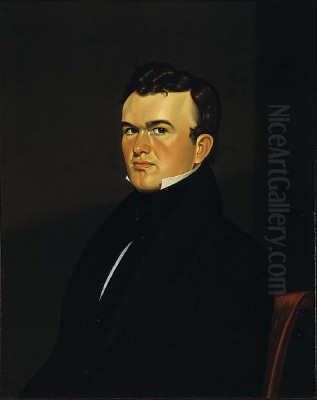
George Caleb Bingham (March 20, 1811 – July 7, 1879) stands as a pivotal figure in 19th-century American art, celebrated for his vivid depictions of life on the Missouri frontier and his insightful portrayals of the era's boisterous political landscape. A largely self-taught artist who also carved out a significant career in Missouri politics, Bingham's work offers a unique window into the formative years of the American West, capturing its characters, its burgeoning democracy, and its natural beauty with a distinctive realist style. His legacy is that of an artist deeply embedded in his time and place, whose canvases continue to resonate with historical and aesthetic significance.
Early Life and Artistic Awakenings
Born on a farm in Augusta County, Virginia, George Caleb Bingham's destiny was tied to the westward expansion of the young American nation. In 1819, when George was eight years old, his family moved to Franklin, Missouri, a bustling settlement on the edge of the American frontier. This early exposure to the raw, dynamic environment of the Missouri River valley would profoundly shape his artistic vision. His father, Henry Vest Bingham, experienced initial success but later faced financial difficulties, and his death from malaria in 1823 left the family in straitened circumstances. Mary, his mother, remarried, and young George was apprenticed to a cabinet maker, a trade that may have honed his sense of craftsmanship and design.
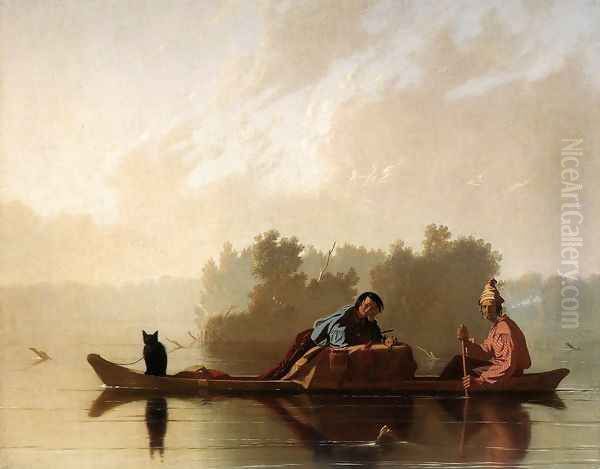
Despite the lack of formal art institutions on the frontier, Bingham's passion for drawing and painting emerged early. He was largely self-taught, learning by observing the world around him and by studying any prints or paintings he could find. A formative encounter occurred around 1820 when the itinerant portrait painter Chester Harding visited Franklin. Harding, who himself had a rugged, self-made background and would go on to paint prominent figures like Daniel Boone, allowed the young Bingham to watch him work. This experience is believed to have ignited Bingham's ambition to become a professional artist. He began his artistic career as an itinerant portrait painter in the early 1830s, traveling through Missouri and Mississippi, capturing the likenesses of local citizens for modest fees. These early portraits, while sometimes stiff, demonstrated a growing skill in capturing character.
His ambition led him to seek further, albeit brief, formal training. In 1838, Bingham made a trip east, spending about three months studying at the Pennsylvania Academy of the Fine Arts in Philadelphia. There, he would have had the opportunity to see works by leading American artists such as Thomas Sully and Gilbert Stuart, as well as casts of classical sculptures. This exposure, though short, likely refined his technique and broadened his artistic horizons. He also visited New York, further immersing himself in the burgeoning American art scene.
The Missouri Artist: Capturing Frontier Life
Returning to Missouri, Bingham's artistic focus began to shift beyond portraiture. While he continued to paint portraits throughout his career to earn a living, his most celebrated works emerged from his deep connection to the Missouri River and the lives of the people who depended on it. He became known as "The Missouri Artist," a title that aptly described his dedication to chronicling the region.
His genre scenes, depicting the everyday activities of boatmen, fur traders, and pioneers, brought a new level of realism and narrative depth to American art. One of his earliest and most iconic masterpieces in this vein is _Fur Traders Descending the Missouri_ (1845). This painting, with its serene atmosphere, meticulous detail, and subtle play of light on the water, captures a quintessential moment of frontier life. The two figures in a dugout canoe, accompanied by a bear cub, glide silently on the misty river, evoking a sense of quietude and the vastness of the American wilderness. The painting showcases Bingham's developing Luminist tendencies, a style characterized by its careful rendering of light and atmosphere to create a sense of calm and often spiritual contemplation, seen in the works of artists like Fitz Henry Lane and Martin Johnson Heade.
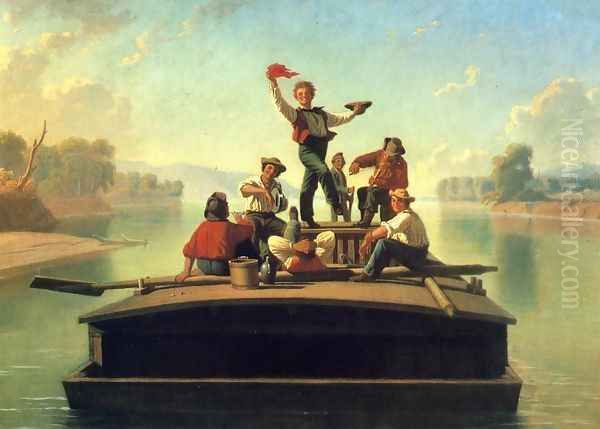
Bingham followed this success with a series of paintings depicting the lively and often boisterous world of the riverboatmen. _The Jolly Flatboatmen_ (1846) became immensely popular, widely distributed through engravings by the American Art-Union. This organization played a crucial role in promoting American artists by purchasing their works and distributing reproductions to a national audience, effectively democratizing art. The painting shows a group of flatboatmen relaxing on their vessel, one dancing to the music of a fiddler, embodying the carefree spirit and camaraderie of river life. He would revisit this theme in later works, such as Raftsmen Playing Cards (1847) and The Jolly Flatboatmen in Port (1857), each offering different perspectives on this vital aspect of Western commerce and culture.
These river paintings are notable for their carefully structured compositions, often employing pyramidal arrangements of figures, and their keen observation of human character and gesture. Bingham's figures are not idealized types but individuals with distinct personalities, rendered with a sympathetic and often humorous eye. His ability to capture the unique dialect of American frontier life set him apart from many of his contemporaries. While artists of the Hudson River School, such as Thomas Cole and Asher B. Durand, were primarily focused on the sublime grandeur of the American landscape, Bingham, like his contemporary William Sidney Mount on Long Island, brought a similar dedication to depicting the human element within that landscape, focusing on genre scenes that told stories of American life.
A Painter in Politics: The Election Series and Social Commentary
Bingham was not merely an observer of his society; he was an active participant. His strong interest in civic life led him into politics. He aligned himself with the Whig Party, which generally advocated for national unity, economic development, and social reforms. In 1846, he ran for the Missouri State Legislature. Though initially declared the winner, the election was contested, and he ultimately lost his seat after a recount. Undeterred, he ran again in 1848 and was successfully elected, serving one term. His political career would continue in various capacities, including serving as Missouri State Treasurer during the Civil War (1862-1865) and later as Adjutant-General of Missouri.
This deep immersion in the political process provided rich material for his art. Between 1852 and 1855, Bingham produced his celebrated Election Series, a group of paintings that vividly document the democratic process in antebellum America. These include _Canvassing for a Vote_ (also known as Country Politician, c. 1851-52), _The County Election_ (1852), _Stump Speaking_ (or The Stump Orator, 1853-54), and _The Verdict of the People_ (1854-55).
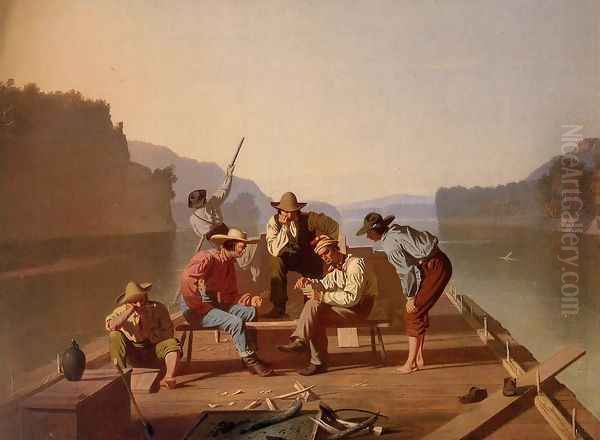
_The County Election_ is perhaps the most famous of the series. It depicts a bustling election day scene in a small Missouri town, filled with a diverse cast of characters engaged in various activities: voting, discussing politics, drinking, and celebrating. Bingham masterfully orchestrates this complex scene, capturing the energy, enthusiasm, and occasional rowdiness of Jacksonian-era democracy. The painting is a nuanced commentary, celebrating the vitality of popular participation while also subtly hinting at the potential for manipulation and intoxication that could accompany such events.
_Stump Speaking_ portrays a politician passionately addressing a crowd from a makeshift platform, while _Canvassing for a Vote_ shows a candidate earnestly trying to persuade a reluctant voter in a more intimate setting, perhaps discussing contentious issues like the Wilmot Proviso, which sought to ban slavery in territories acquired from Mexico. _The Verdict of the People_ captures the moment the election results are announced, showcasing a range of reactions from jubilation to disappointment.
These paintings are remarkable for their detailed observation, their complex figural arrangements, and their insightful portrayal of American political culture. They reveal Bingham's Whig sensibilities, his belief in an informed and engaged citizenry, but also his awareness of the imperfections and human foibles inherent in the democratic process. Art historian Nancy Rash, in her book The Painting and Politics of George Caleb Bingham, has extensively explored how Bingham's political views and experiences informed these works, making him a significant visual commentator on American democracy.
European Sojourn and Artistic Development
Seeking to further refine his skills and broaden his artistic knowledge, Bingham, like many ambitious American artists of his time, traveled to Europe. From 1856 to 1859, he spent time primarily in Düsseldorf, Germany, with a period in Paris. The Düsseldorf Academy was a major center for artistic training, attracting many American painters, including Emanuel Leutze (famous for Washington Crossing the Delaware), Albert Bierstadt, and Worthington Whittredge.
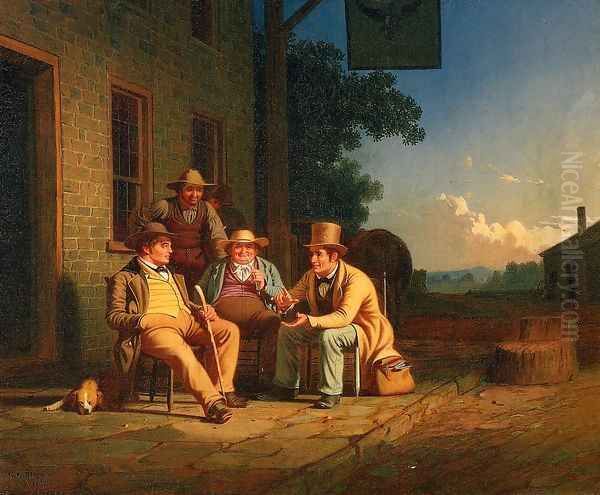
In Düsseldorf, Bingham was exposed to a more polished, academic style of painting, characterized by precise drawing, smooth brushwork, and often sentimental or historical themes. While he absorbed some of these technical aspects, his core commitment to American subjects remained. His time in Europe, particularly his study of Old Masters in museums like the Louvre in Paris, likely reinforced his interest in complex figural compositions and narrative clarity. Some critics note a shift towards more idealized figures and a somewhat more sentimental tone in his work after his return from Europe, though his fundamental realism and focus on American themes persisted. He also received commissions for portraits of prominent figures like George Washington and Thomas Jefferson during this period, intended for the Missouri State Capitol.
The Civil War and Its Aftermath
The outbreak of the American Civil War in 1861 profoundly impacted Bingham. A staunch Unionist, he actively participated in the war effort. He served as captain of a volunteer company he organized in Kansas City to defend the Union. Later, as Missouri State Treasurer from 1862 to 1865, he played a crucial role in managing the state's finances during a tumultuous period. Missouri, as a border state, was deeply divided, experiencing brutal guerrilla warfare.
One of Bingham's most powerful and controversial paintings, _Martial Law or Order No. 11_ (completed c. 1869-1870), was a direct response to a wartime atrocity. General Order No. 11 was issued in 1863 by Union General Thomas Ewing Jr. in an attempt to suppress Confederate guerrilla activity in western Missouri. The order mandated the forced evacuation of civilians from several counties, leading to immense suffering, displacement, and destruction of property. Bingham, who personally knew Ewing and vehemently opposed the order, depicted the scene with raw emotional intensity, showing Union soldiers callously driving families from their homes. The painting is a stark indictment of military overreach and the devastating human cost of war. It reflects Bingham's deep sense of justice and his willingness to use his art as a form of political protest. He created two versions of this painting and also had it engraved to ensure wider dissemination of his protest.
The war and its aftermath took a personal toll. His first wife, Sarah Elizabeth Hutchison, with whom he had several children, had died in 1848. He remarried twice, first to Eliza Thomas, who also predeceased him, and then to Martha Lykins. His political career continued after the war; he was appointed Adjutant-General of Missouri in 1875, tasked with reorganizing the state militia.
Later Career and Academic Role
In his later years, Bingham continued to paint portraits, which remained a consistent source of income. His style in these later portraits often reflected the smoother finish and more conventional approach influenced by his European studies. However, his most enduring legacy remained his genre scenes and political paintings from the antebellum period.
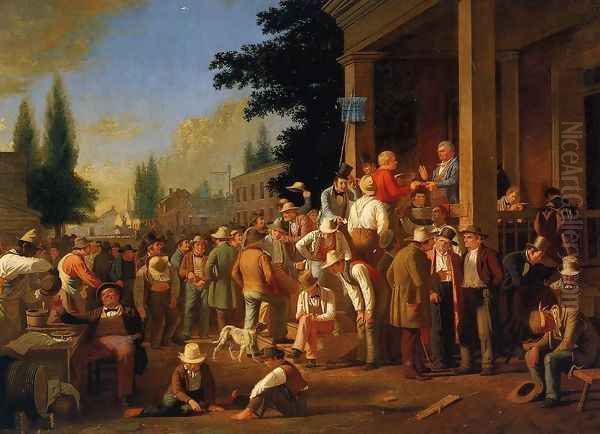
A significant development in his later career was his appointment in 1877 as the first Professor of Art at the University of Missouri in Columbia. This position acknowledged his stature as the state's preeminent artist and provided him with an opportunity to mentor a new generation of artists. Unfortunately, his tenure was cut short by his declining health. George Caleb Bingham died of cholera in Kansas City, Missouri, on July 7, 1879, leaving behind a rich and varied body of work that continues to be studied and admired.
Artistic Style and Techniques
George Caleb Bingham's style is primarily characterized as American Realism, with significant elements of Luminism, particularly in his river landscapes. He possessed a keen eye for detail and a remarkable ability to capture the nuances of human expression and gesture. His compositions were carefully planned, often utilizing classical pyramidal structures to organize groups of figures and create a sense of balance and harmony. He made extensive preparatory sketches and drawings for his major paintings, meticulously working out the placement and poses of individual figures.
His use of light was particularly distinctive. In paintings like Fur Traders Descending the Missouri, the soft, diffused light creates a palpable atmosphere, imbuing the scene with a sense of tranquility and mystery. In his Election Series, light is used more dramatically to highlight key figures and direct the viewer's attention within complex, multi-figure compositions. His color palette was generally rich and naturalistic, though it could become more vibrant in his depictions of lively scenes.
While largely self-taught, Bingham absorbed influences from various sources. The meticulous detail and narrative focus of 17th-century Dutch genre painters, such as Jan Steen or Adriaen Brouwer, find echoes in his work, as does the tradition of English genre painting exemplified by artists like David Wilkie. His brief academic training and European travels added a degree of polish and sophistication to his technique, but his vision remained rooted in the American experience.
Connections and Contemporaries
Bingham operated within a vibrant, if geographically dispersed, American art world. His early encounter with Chester Harding was formative. His relationship with the American Art-Union was crucial for disseminating his work and building his national reputation, a service the Union also provided for artists like Frederic Edwin Church and Eastman Johnson.
In Europe, his time in Düsseldorf connected him to a significant school of painting that influenced many Americans, including Emanuel Leutze, Albert Bierstadt, and Worthington Whittredge. While their subject matter often differed – Leutze with grand historical narratives, Bierstadt with dramatic Western landscapes – they shared an emphasis on technical skill and detailed rendering.
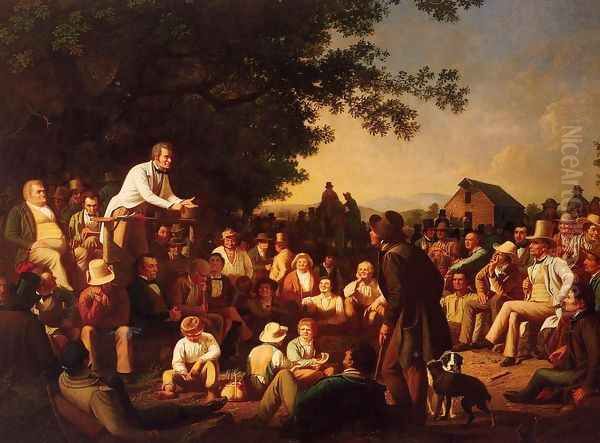
Bingham's Luminist qualities align him with painters like Fitz Henry Lane, Martin Johnson Heade, Sanford Robinson Gifford, and John Frederick Kensett, who all explored the subtle effects of light and atmosphere in American landscapes, though Bingham's focus was often more on the human presence within those landscapes.
As a genre painter, he can be compared to William Sidney Mount, who documented rural life on Long Island with a similar blend of realism and gentle humor. Later artists like Winslow Homer and Thomas Eakins would further develop American Realism, but Bingham was a key figure in establishing this tradition, particularly in his depiction of Western themes. His political paintings stand somewhat unique, though artists like John Lewis Krimmel had earlier depicted scenes of American civic life.
Legacy and Enduring Influence
George Caleb Bingham's reputation has experienced fluctuations. Highly regarded during his lifetime, especially for his genre scenes popularized by the American Art-Union, his work fell into relative obscurity for a period after his death, as artistic tastes shifted towards Impressionism and other modern movements. However, the 20th century saw a significant revival of interest in his work, particularly beginning in the 1930s, as art historians and curators recognized his unique contribution to American art and his importance as a visual chronicler of a pivotal era in American history.
Today, Bingham is celebrated as one of the foremost American painters of the 19th century. His works are prized for their aesthetic quality, their historical insight, and their quintessential American character. They offer invaluable glimpses into the social, political, and economic life of the American frontier, particularly the Missouri River valley. His paintings are held in major museum collections across the United States, including the Metropolitan Museum of Art in New York, the National Gallery of Art in Washington, D.C., the Saint Louis Art Museum, and the Nelson-Atkins Museum of Art in Kansas City. The State Historical Society of Missouri and the University of Missouri also hold significant collections of his work.
His legacy extends beyond his canvases. The town of Bingham, Illinois, is named in his honor, and various institutions, including the George Caleb Bingham Middle School in Independence, Missouri, and the George Caleb Bingham Gallery at the University of Missouri, commemorate his contributions. His life and work continue to be the subject of scholarly research, exhibitions, and popular appreciation, securing his place as a vital interpreter of the American experience.
Conclusion
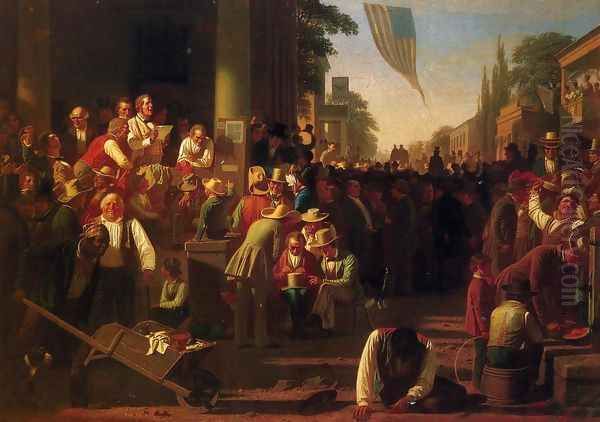
George Caleb Bingham was more than just a painter; he was a participant-observer, an artist deeply engaged with the currents of his time. From the tranquil, misty mornings on the Missouri River to the boisterous energy of a county election, his canvases captured the essence of a nation in formation. His dual career as an artist and a politician gave him a unique perspective, allowing him to depict American life with both intimacy and critical insight. As a chronicler of the frontier, a commentator on democracy, and a master of realist expression, George Caleb Bingham created an enduring visual record of 19th-century America, solidifying his status as one of the nation's most important and beloved artists.